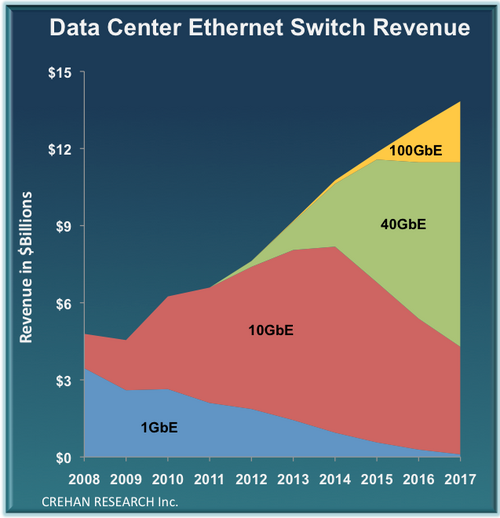Networking has one of the longest refresh cycles of any technology in the datacenter, leading to slow adoption of new technology. Service providers and hyperscale companies have growth patterns that require them to refresh technology much faster than the typical enterprise datacenter. These companies are the early adopters of new bandwidth speeds and the first to deploy SDN.
Higher network speeds can often be added to existing hardware, so unless there is a compelling reason to change, incumbent vendors have a strong position (as proven out by market leader Cisco’s ability to stay on top from 100MB to 1Gb to 10Gb Ethernet transitions). Many vendors pushed new-generation architectures during the transition to 10Gb Ethernet (see the Wikibon Peer Incite with Peek Colo on Ethernet Fabrics). While these solutions have gained traction (including as part of Cisco’s Nexus line), they have not significantly moved the needle on market share.
The networking landscape has consolidated, and what was previously described as “Snow White and the 7 Dwarves” – a description of how Cisco’s market share dominated the other players, which were all fighting for a small remaining market share – is now still led by Cisco, with a number of players trying to climb higher. The wave of SDN is a more disruptive trend (see Sorting out SDN, NFV, Network Virtualization and the New Networking), which is giving vendors hope that new software-centric solutions will break Cisco’s dominance in networking hardware:
- HP Networking is a clear #2 through the combination of its ProCurve and the 3COM acquisition. HP Networking has rebranded and streamlined its portfolio. HP believes that it can utilize the architectural changes of SDN and open standards to compete with Cisco (see video of HP Networking CTO Dave Larson)
- Dell Networking has emerged as a surprising #3 in market share through a combination of its existing campus solutions, along with strong growth since the acquisition of Force10. Dell’s Force10 has an early #2 position in 40Gb Ethernet solutions; it is expected that there will be strong growth in 40Gb revenue over the next few years (see chart).
- Juniper, Brocade, and Arista have yet to break from the pack on revenue. As independent networking companies, they have an uphill battle getting into enterprise IT environments that today prefer solutions over best-of-breed technologies. These vendors are also pushing into service providers that have a faster growth pattern for networking
- The commoditization trend is orthogonal to SDN; white box solutions from Taiwanese manufacturers are gaining market share, predominately in massive Web-scale environments.
Of course, Cisco is not sitting still. In addition to a growing datacenter business, including the Nexus product line, there is the impending Insieme spin-in. While Insieme’s strategy is not public, it is sure to have a strong SDN aspect and likely to push towards higher bandwidth and larger scale networks (and definitely not a storage solution as some rumors said).
Action Item: Architectural redesigns and generation upgrades are an obvious time for companies to reevaluate vendor relationships. While software-led solutions like SDN hold the promise of allowing customers to be more hardware-agnostic, it will take some time to see if OpenDaylight and standards can deliver on this. The SDN wave is the biggest disruption to networking in the last 15 years; users are urged to dig into the solutions and choose partners that understand the applications and needs of the business.
Footnotes: Seamus Crehan’s comments on the revenue forecast:
10GbE: Over 70% of 2012 revenue mix (note that server ports are still shipping more 1Gb than 10Gb)
40GbE: Majority of data center switch revenues in outer years of forecast. Forecasting much faster ramp than 10GbE
100GbE: Small port but significant revenue contributor by outer forecast years



